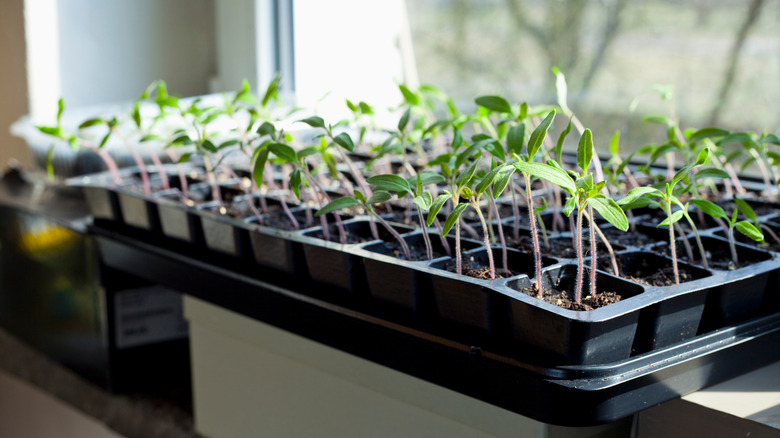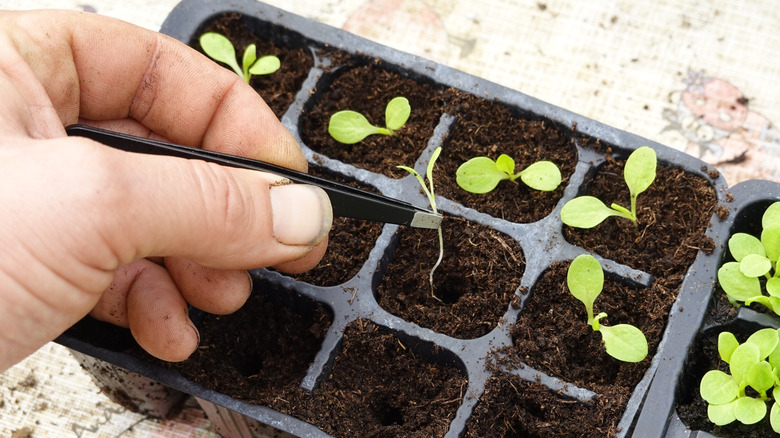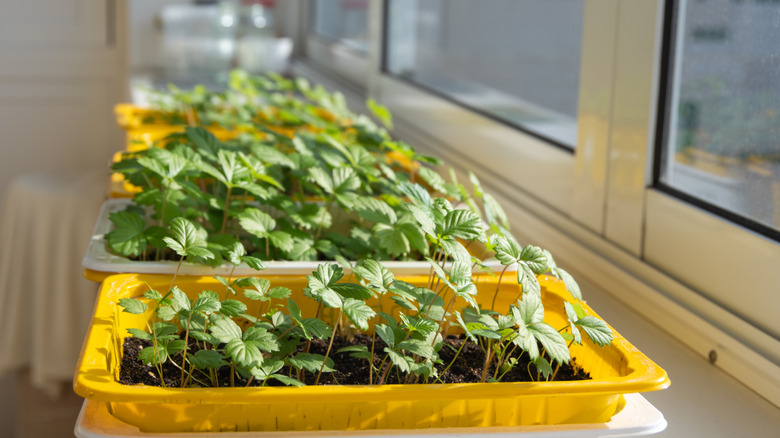Fix Weak, Leggy Seedlings With These Simple Gardening Tips
You check on your seedlings and notice they're stretching for the sky a little too much. They're tall, thin, and pale. Leggy seedlings arguably rank number one among the spring garden prepping mistakes you'll want to avoid. Why? Frankly stated, you have a tray of seedlings unlikely to make it out into your carefully prepared garden beds. However, all is not lost. If you improve lighting conditions, prune branching species, thin out cells you've multi-seeded, or even replant the seedlings right up to their first set of leaves, you might just be able to fix them. Of course, prevention is better than a fix. Keep temperatures cool, improve airflow, and provide lots of bright, natural light when germinating those seeds, and legginess may not be a worry.
Legginess is caused by ill-suited growing conditions — typically, a location too dark, still, damp, and warm. Seeds started in low light will grow tall and thin, in a process called etiolation. They may turn to face the brightest nearby light source, stretching and weakening their stems in the process. Even placing your seedling trays on a sunny windowsill might not work; many window coatings block out the parts of the light spectrum needed for healthy growth. The low light of spring might be a factor, too. Other factors leading to legginess include overcrowding (seeds planted close together compete for light); inconsistent watering, which inhibits photosynthesis in warm and bright conditions; and leaving seedlings in a germination chamber for too long. While high temperatures might not cause gangly seeds, they can exacerbate the issue.
Tips to try if your seedlings are already leggy
Insufficient light is a common cause of legginess, so start by addressing that. A sunny windowsill rarely cuts it, but if that's all you have, try it first. Better yet, move indoor seedlings outside into the sun gradually to avoid burning their leaves or stressing them out. If that's not possible, you'll need to choose the perfect grow light to help your plants thrive. Position two 40-watt fluorescent or full-spectrum LED lights between 2 and 12 inches above your rangy seedlings and keep them on between 14 and 18 hours a day. You may have to experiment with the bulb strength, distance, and quantity depending on the plant species. If your initial setup isn't working, try stronger bulbs, position them closer, or use more of them.
You can also remedy overgrowth by top-pruning your seedlings, especially with branching species like basil, tomatoes, and peppers. Cutting or pinching off the tops of the seedlings just above the two seed leaves urges them to bush out. If you've multi-seeded each cell of your trays, prevent legginess-inducing crowding by pulling out the weak seedlings and leaving a single strong plant in each cell.
Not ready to give up on your spindly seedlings? You're in luck if you're growing eggplants, tomatoes, peppers, brassicas, and certain annual flowers. You can transplant them to larger pots, burying them up to the first set of leaves, or dig a trench in your garden bed a little deeper than the length of the seedling stems and bury them in there. New roots will appear on the submerged portion of the stems.
Prevention is the best fix for leggy seedlings
When sowing, fill your cells completely to avoid light-blocking shadows and use the right germination mix — artificial substrates are known to cause legginess. Plant just a few seeds in each cell; or, if using a tray, aim for at least 1½ inches between each seed. Take note, too, of the sowing times for the species you want to grow. For example, plant cosmos seeds in sunlight-parched late winter or early spring, and you're almost guaranteed long, thin seedlings.
Once the seeds sprout, maintain a temperature between 55 (nighttime) and 70 (daytime) degrees Fahrenheit. Remove heating mats or germination domes at this time, too. If you're growing indoors, spare bedrooms and other rarely used rooms often provide the best conditions for seedlings. Water minimally in the first three weeks after germination. Bottom watering, where you place the seedling's growing container in a dish of water, may strengthen the roots by encouraging them to grow longer and deeper into the cell, pot, or tray. Only give balanced fertilizer or houseplant food diluted to half strength after the first true leaves have fully emerged to avoid a reediness-inducing nitrogen boost.
Bulking up the medium around the seedling bases, or placing a toothpick next to the seedlings (a wooden skewer will work, too), may keep seedlings from falling over after transplantation or while you fix their growing environment. Likewise, try brushing the young plants' tops gently with a broomstick or piece of plastic pipe. Known as mechanical stimulation, this method is proven to prevent legginess.


